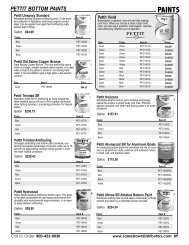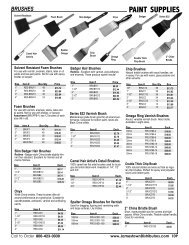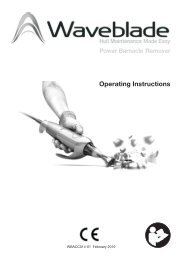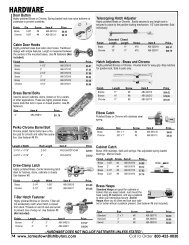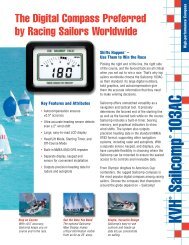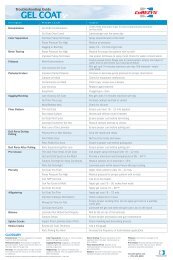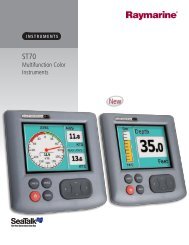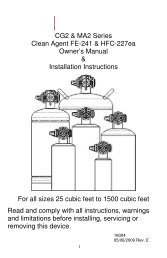technical manu al table of contents - Jamestown Distributors
technical manu al table of contents - Jamestown Distributors
technical manu al table of contents - Jamestown Distributors
You also want an ePaper? Increase the reach of your titles
YUMPU automatically turns print PDFs into web optimized ePapers that Google loves.
One-component clear varnish system<br />
on wood above the waterline<br />
Surface Preparation:<br />
Bare wood must be clean, dry and free <strong>of</strong> grease etc. Degrease with Epifanes Spray Thinner For Paint & Varnish or denatured <strong>al</strong>cohol. Wiping down with miner<strong>al</strong> or white<br />
spirits, may leave an oily residue. Do not use water. Sand the bare wood to a fresh surface with 60 - 80 grit dry abrasive paper with the grain <strong>of</strong> the wood. A block may be used<br />
to assist in fairing the surface. Finish sand with 100 - 120 grit dry abrasive paper. If desired, stain the wood at this time with a good qu<strong>al</strong>ity oil or water based stain. Do not<br />
color the varnish itself as this will create a muddy appearance. Brush application with a good qu<strong>al</strong>ity, clean, natur<strong>al</strong> bristle brush will give good results. Try an Epifanes brush<br />
for the ultimate varnishing experience. Foam brushes are convenient on sm<strong>al</strong>ler projects however, are not sui<strong>table</strong> for larger jobs. "Roll and tip" is a great method for large flat<br />
areas. 3" foam roller followed by a bristle brush is the best combination.<br />
Coats Product Thinner Thinning<br />
Ratio %<br />
Drying Time<br />
in hours<br />
Abrasive<br />
paper grit<br />
Abrasive<br />
paper type<br />
Approx.<br />
coverage /<br />
Remarks<br />
First<br />
Second<br />
Third<br />
At least<br />
4 more<br />
Epifanes<br />
Clear Gloss<br />
Epifanes<br />
Clear Gloss<br />
Epifanes<br />
Clear Gloss<br />
Epifanes<br />
Clear Gloss<br />
Brush Thinner<br />
For P&V<br />
Brush Thinner<br />
For P&V<br />
Brush Thinner<br />
For P&V<br />
Brush Thinner<br />
For P&V<br />
50 24 at 65F. 220 Dry 150 - 300 sq.<br />
feet<br />
25<br />
15<br />
0 - 5<br />
24 at 65F.<br />
24 at 65F.<br />
24 at 65F.<br />
280<br />
320<br />
320-400<br />
Dry<br />
Dry<br />
Wet or Dry<br />
150 - 250 sq.<br />
feet<br />
150 - 200 sq.<br />
feet<br />
150 sq.<br />
feet<br />
Do not sand<br />
through the<br />
stain<br />
Sand by<br />
hand.<br />
Machines<br />
can be too<br />
aggressive.<br />
Maintenance:<br />
If existing coats <strong>of</strong> varnish are intact, one or more coats may be applied on a well cleaned, degreased and lightly sanded surface. For annu<strong>al</strong> maintenance, apply a minimum <strong>of</strong><br />
one or two coats <strong>of</strong> Epifanes Clear Gloss Varnish, following surface preparation instruction. The number <strong>of</strong> maintenance coats needed depends on the condition <strong>of</strong> the varnish<br />
system. Epifanes Clear Gloss Varnish may <strong>al</strong>so be applied on any well cleaned, degreased and sanded two-component varnish. The weather and atmospheric conditions to<br />
which the finish is subjected will determine the amount <strong>of</strong> time between coats. An existing varnish system in poor condition must be removed. Weathered spots may be treated<br />
with a cleaning or bleaching product. If either are used, wash down the surface thoroughly with fresh water in order to remove any residue. Allow the surface to dry. Sm<strong>al</strong>ler<br />
spots needing repair may be filled with sever<strong>al</strong> coats <strong>of</strong> varnish. When an equ<strong>al</strong> level has been achieved, sand to a smooth surface and apply one or more coats <strong>of</strong> varnish on<br />
the entire surface.



